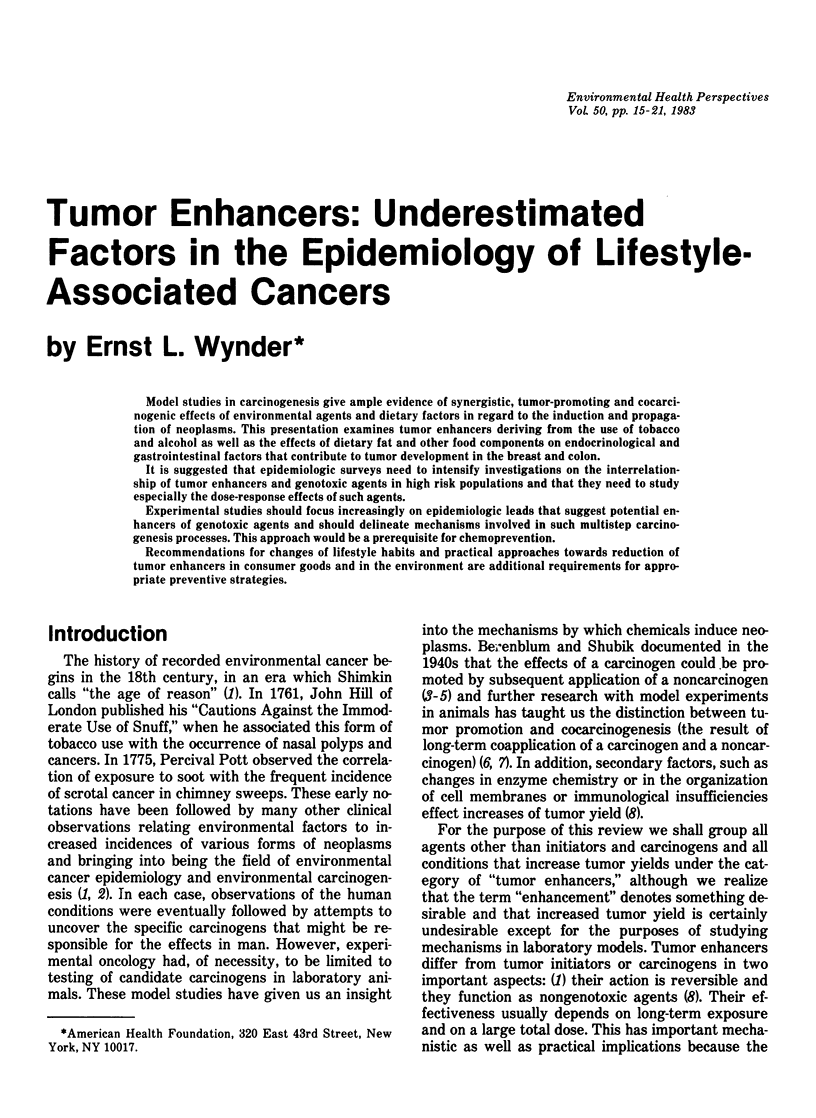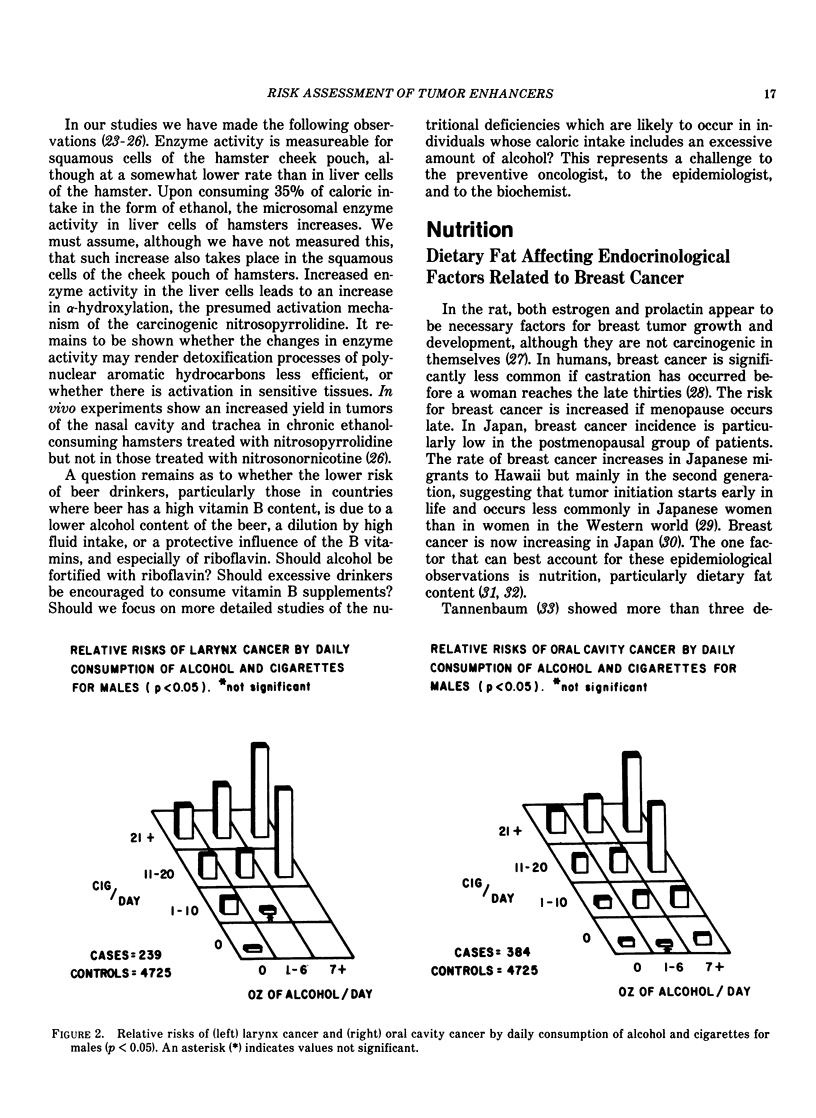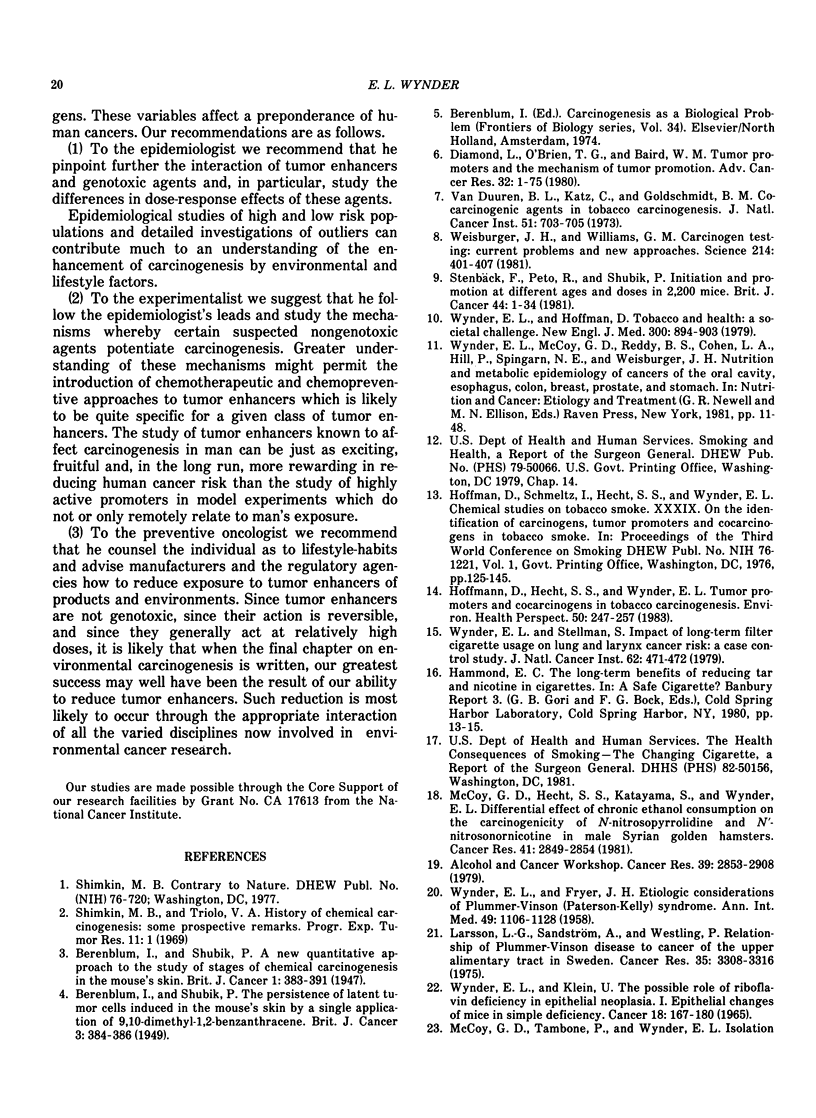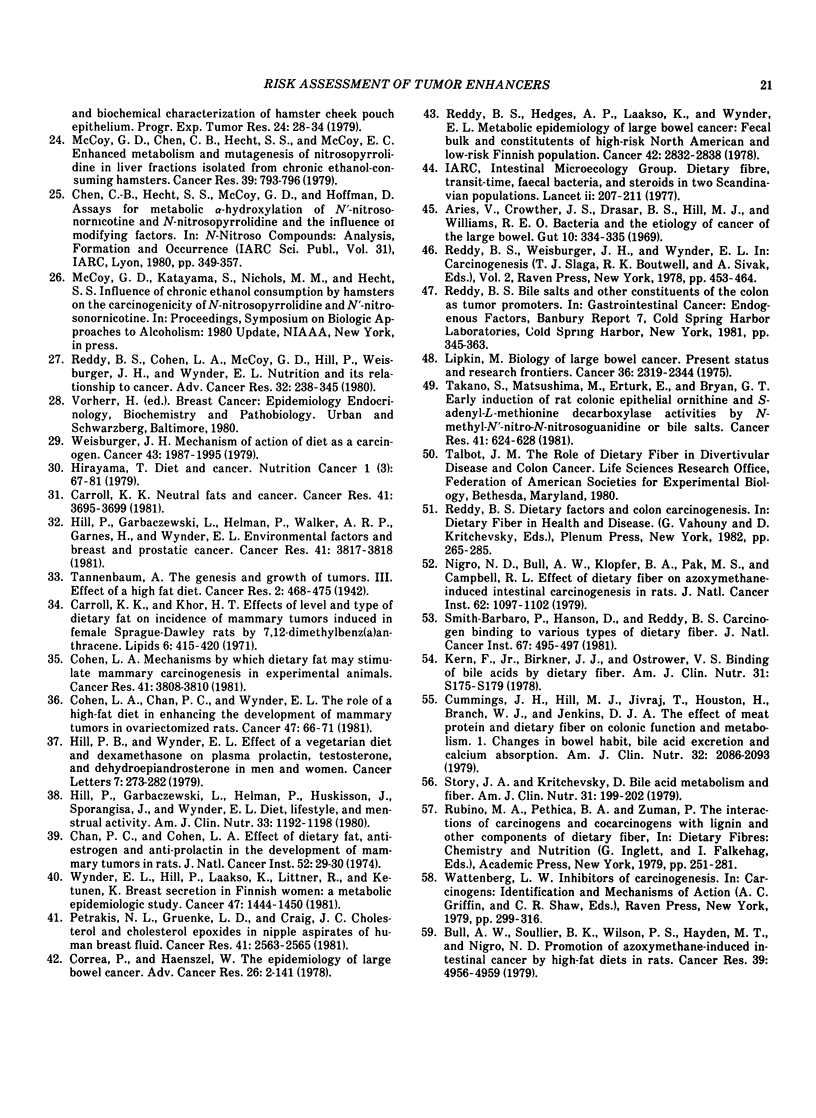Abstract
Model studies in carcinogenesis give ample evidence of synergistic, tumor-promoting and cocarcinogenic effects of environmental agents and dietary factors in regard to the induction and propagation of neoplasms. This presentation examines tumor enhancers deriving from the use of tobacco and alcohol as well as the effects of dietary fat and other food components on endocrinological and gastrointestinal factors that contribute to tumor development in the breast and colon. It is suggested that epidemiologic surveys need to intensify investigations on the interrelationship of tumor enhancers and genotoxic agents in high risk populations and that they need to study especially the dose-response effects of such agents. Experimental studies should focus increasingly on epidemiologic leads that suggest potential enhancers of genotoxic agents and should delineate mechanisms involved in such multistep carcinogenesis processes. This approach would be a prerequisite for chemoprevention. Recommendations for changes of lifestyle habits and practical approaches towards reduction of tumor enhancers in consumer goods and in the environment are additional requirements for appropriate preventive strategies.
Full text
PDF






Selected References
These references are in PubMed. This may not be the complete list of references from this article.
- Aries V., Crowther J. S., Drasar B. S., Hill M. J., Williams R. E. Bacteria and the aetiology of cancer of the large bowel. Gut. 1969 May;10(5):334–335. doi: 10.1136/gut.10.5.334. [DOI] [PMC free article] [PubMed] [Google Scholar]
- BERENBLUM I., SHUBIK P. The persistence of latent tumour cells induced in the mouse's skin by a single application of 9:10-dimethyl-1:2-benzanthracene. Br J Cancer. 1949 Sep;3(3):384–386. doi: 10.1038/bjc.1949.42. [DOI] [PMC free article] [PubMed] [Google Scholar]
- Bull A. W., Soullier B. K., Wilson P. S., Hayden M. T., Nigro N. D. Promotion of azoxymethane-induced intestinal cancer by high-fat diet in rats. Cancer Res. 1979 Dec;39(12):4956–4959. [PubMed] [Google Scholar]
- Carroll K. K., Khor H. T. Effects of level and type of dietary fat on incidence of mammary tumors induced in female Sprague-Dawley rats by 7,12-dimethylbenz()anthracene. Lipids. 1971 Jun;6(6):415–420. doi: 10.1007/BF02531379. [DOI] [PubMed] [Google Scholar]
- Carroll K. K. Neutral fats and cancer. Cancer Res. 1981 Sep;41(9 Pt 2):3695–3699. [PubMed] [Google Scholar]
- Chan P. C., Cohen L. A. Effect of dietary fat, antiestrogen, and antiprolactin on the development of mammary tumors in rats. J Natl Cancer Inst. 1974 Jan;52(1):25–30. doi: 10.1093/jnci/52.1.25. [DOI] [PubMed] [Google Scholar]
- Chen C. B., Hecht S. S., McCoy G. D., Hoffmann D. Assays for metabolic alpha-hydroxylation of N'-nitrosonornicotine and N-nitrosopyrrolidine and the influence of modifying factors. IARC Sci Publ. 1980;(31):349–359. [PubMed] [Google Scholar]
- Cohen L. A., Chan P. C., Wynder E. L. The role of a high-fat diet in enhancing the development of mammary tumors in ovariectomized rats. Cancer. 1981 Jan 1;47(1):66–71. doi: 10.1002/1097-0142(19810101)47:1<66::aid-cncr2820470113>3.0.co;2-m. [DOI] [PubMed] [Google Scholar]
- Cohen L. A. Mechanisms by which dietary fat may stimulate mammary carcinogenesis in experimental animals. Cancer Res. 1981 Sep;41(9 Pt 2):3808–3810. [PubMed] [Google Scholar]
- Correa P., Haenszel W. The epidemiology of large-bowel cancer. Adv Cancer Res. 1978;26:1–141. doi: 10.1016/s0065-230x(08)60086-x. [DOI] [PubMed] [Google Scholar]
- Cummings J. H., Hill M. J., Jivraj T., Houston H., Branch W. J., Jenkins D. J. The effect of meat protein and dietary fiber on colonic function and metabolism. I. Changes in bowel habit, bile acid excretion, and calcium absorption. Am J Clin Nutr. 1979 Oct;32(10):2086–2093. doi: 10.1093/ajcn/32.10.2086. [DOI] [PubMed] [Google Scholar]
- Hill P. B., Wynder E. L. Effect of a vegetarian diet and dexamethasone on plasma prolactin, testosterone and dehydroepiandrosterone in men and women. Cancer Lett. 1979 Sep;7(5):273–282. doi: 10.1016/s0304-3835(79)80054-3. [DOI] [PubMed] [Google Scholar]
- Hill P., Garbaczewski L., Helman P., Huskisson J., Sporangisa E., Wynder E. L. Diet, lifestyle, and menstrual activity. Am J Clin Nutr. 1980 Jun;33(6):1192–1198. doi: 10.1093/ajcn/33.6.1192. [DOI] [PubMed] [Google Scholar]
- Hill P., Garbaczewski L., Helman P., Walker A. R., Garnes H., Wynder E. L. Environmental factors and breast and prostatic cancer. Cancer Res. 1981 Sep;41(9 Pt 2):3817–3818. [PubMed] [Google Scholar]
- Hoffmann D., Hecht S. S., Wynder E. L. Tumor promoters and cocarcinogens in tobacco carcinogenesis. Environ Health Perspect. 1983 Apr;50:247–257. doi: 10.1289/ehp.8350247. [DOI] [PMC free article] [PubMed] [Google Scholar]
- Kern F., Jr, Birkner H. J., Ostrower V. S. Binding of bile acids by dietary fiber. Am J Clin Nutr. 1978 Oct;31(10 Suppl):S175–S179. doi: 10.1093/ajcn/31.10.S175. [DOI] [PubMed] [Google Scholar]
- Larsson L. G., Sandström A., Westling P. Relationship of Plummer-Vinson disease to cancer of the upper alimentary tract in Sweden. Cancer Res. 1975 Nov;35(11 Pt 2):3308–3316. [PubMed] [Google Scholar]
- Lipkin M. Biology of large bowel cancer. Present status and research frontiers. Cancer. 1975 Dec;36(6 Suppl):2319–2324. doi: 10.1002/1097-0142(197512)36:6<2319::aid-cncr2820360606>3.0.co;2-c. [DOI] [PubMed] [Google Scholar]
- McCoy G. D., Chen C. H., Hecht S. S., McCoy E. C. Enhanced metabolism and mutagenesis of nitrosopyrrolidine in liver fractions isolated from chronic ethanol-consuming hamsters. Cancer Res. 1979 Mar;39(3):793–796. [PubMed] [Google Scholar]
- McCoy G. D., Hecht S. S., Katayama S., Wynder E. L. Differential effect of chronic ethanol consumption on the carcinogenicity of N-nitrosopyrrolidine and N'-nitrosonornicotine in male Syrian golden hamsters. Cancer Res. 1981 Jul;41(7):2849–2854. [PubMed] [Google Scholar]
- McCoy G. D., Tambone P. C., Wynder E. L. Isolation and biochemical characterization of hamster cheek pouch epithelium. Prog Exp Tumor Res. 1979;24:28–36. doi: 10.1159/000402081. [DOI] [PubMed] [Google Scholar]
- Nigro N. D., Bull A. W., Klopfer B. A., Pak M. S., Campbell R. L. Effect of dietary fiber on azoxymethane-induced intestinal carcinogenesis in rats. J Natl Cancer Inst. 1979 Apr;62(4):1097–1102. [PubMed] [Google Scholar]
- Petrakis N. L., Gruenke L. D., Craig J. C. Cholesterol and cholesterol epoxides in nipple aspirates of human breast fluid. Cancer Res. 1981 Jun;41(6):2563–2565. [PubMed] [Google Scholar]
- Reddy B. S., Cohen L. A., McCoy G. D., Hill P., Weisburger J. H., Wynder E. L. Nutrition and its relationship to cancer. Adv Cancer Res. 1980;32:237–345. doi: 10.1016/s0065-230x(08)60363-2. [DOI] [PubMed] [Google Scholar]
- Reddy B. S., Hedges A. R., Laakso K., Wynder E. L. Metabolic epidemiology of large bowel cancer: fecal bulk and constituents of high-risk North American and low-risk Finnish population. Cancer. 1978 Dec;42(6):2832–2838. doi: 10.1002/1097-0142(197812)42:6<2832::aid-cncr2820420644>3.0.co;2-l. [DOI] [PubMed] [Google Scholar]
- Smith-Barbaro P., Hanson D., Reddy B. S. Carcinogen binding to various types of dietary fiber. J Natl Cancer Inst. 1981 Aug;67(2):495–497. [PubMed] [Google Scholar]
- Takano S., Matsushima M., Ertürk E., Bryan G. T. Early induction of rat colonic epithelial ornithine and S-adenosyl-L-methionine decarboxylase activities by N-methyl-N'-nitro-N-nitrosoguanidine or bile salts. Cancer Res. 1981 Feb;41(2):624–628. [PubMed] [Google Scholar]
- Van Duuren B. L., Katz C., Goldschmidt B. M. Cocarcinogenic agents in tobacco carcinogenesis. J Natl Cancer Inst. 1973 Aug;51(2):703–705. [PubMed] [Google Scholar]
- WYNDER E. L., FRYER J. H. Etiologic considerations of Plummer-Vinson (Patterson-Kelly) syndrome. Ann Intern Med. 1958 Nov;49(5):1106–1128. doi: 10.7326/0003-4819-49-5-1106. [DOI] [PubMed] [Google Scholar]
- WYNDER E. L., KLEIN U. E. THE POSSIBLE ROLE OF RIBOFLAVIN DEFICIENCY IN EPITHELIAL NEOPLASIA. I. EPITHELIAL CHANGES OF MICE IN SIMPLE DEFICIENCY. Cancer. 1965 Feb;18:167–180. doi: 10.1002/1097-0142(196502)18:2<167::aid-cncr2820180208>3.0.co;2-r. [DOI] [PubMed] [Google Scholar]
- Weisburger J. H. Mechanism of action of diet as a carcinogen. Cancer. 1979 May;43(5 Suppl):1987–1995. doi: 10.1002/1097-0142(197905)43:5+<1987::aid-cncr2820430706>3.0.co;2-#. [DOI] [PubMed] [Google Scholar]
- Weisburger J. H., Williams G. M. Carcinogen testing: current problems and new approaches. Science. 1981 Oct 23;214(4519):401–407. doi: 10.1126/science.7291981. [DOI] [PubMed] [Google Scholar]
- Wynder E. L., Hill P., Laakso K., Littner R., Kettunen K. Breast secretion in Finnish women: a metabolic epidemiologic study. Cancer. 1981 Mar 15;47(6):1444–1450. doi: 10.1002/1097-0142(19810315)47:6<1444::aid-cncr2820470634>3.0.co;2-a. [DOI] [PubMed] [Google Scholar]
- Wynder E. L., Hoffmann D. Tobacco and health: a societal challenge. N Engl J Med. 1979 Apr 19;300(16):894–903. doi: 10.1056/NEJM197904193001605. [DOI] [PubMed] [Google Scholar]
- Wynder E. L., Stellman S. D. Impact of long-term filter cigarette usage on lung and larynx cancer risk: a case-control study. J Natl Cancer Inst. 1979 Mar;62(3):471–477. doi: 10.1093/jnci/62.3.471. [DOI] [PubMed] [Google Scholar]


